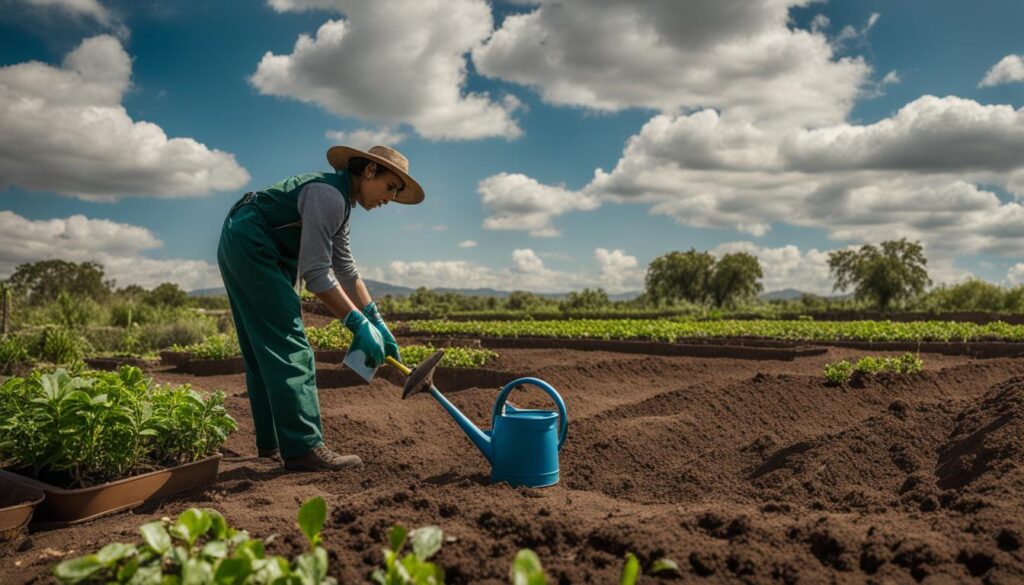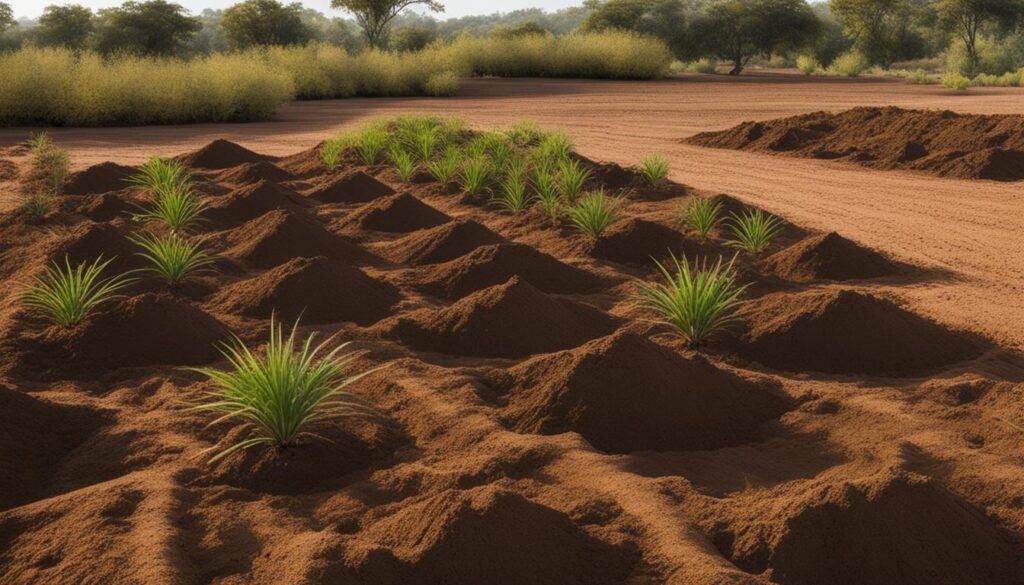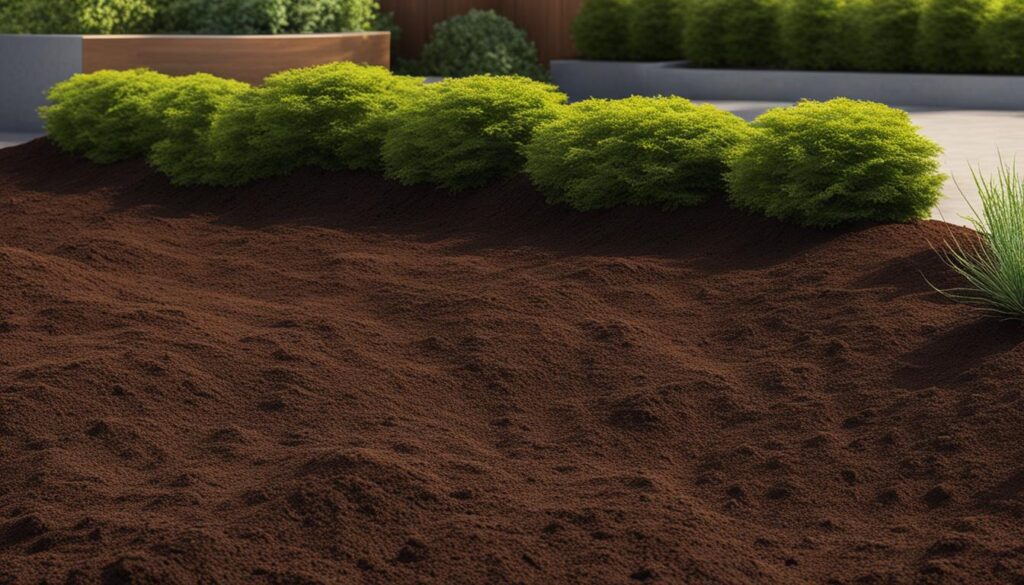In this expert guide, you will learn valuable insights and techniques for improving sandy soil to enhance its drought resistance. Sandy soil poses unique challenges due to its poor water and nutrient retention capacities. By understanding the characteristics of sandy soil and implementing specific management practices, you can optimize its fertility and water-holding abilities, and create an environment that supports the growth of drought-tolerant plants.
Key Takeaways:
- Organic matter is the most effective amendment for improving sandy soil, enhancing its water-holding and nutrient-retention capacities.
- Frequent irrigation and regular fertilization are necessary for sandy soil due to its poor water and nutrient retention abilities.
- Choosing drought-tolerant plants with shallow root systems and low water requirements is essential for successful gardening in sandy soil.
- Proper drainage is crucial for sandy soil to prevent waterlogging and improve overall soil health.
- Testing and adjusting the pH and nutrient levels of sandy soil can guide necessary amendments and ensure optimal plant growth.
Understanding Sandy Soil and Its Challenges
Sandy soil, characterized by its high percentage of sand particles, presents unique challenges for gardeners and landscapers. With poor water retention and low nutrient levels, sandy soil requires special attention and management techniques to support healthy plant growth.
One of the primary difficulties with sandy soil is its poor water retention capacity. Due to the large size of sand particles, water drains quickly through the soil, leaving it dry and unable to provide adequate hydration for plants. As a result, sandy soil is prone to drought stress and requires frequent watering to maintain optimal moisture levels. Gardeners should monitor soil moisture regularly and irrigate their sandy soil accordingly to prevent water stress and ensure the well-being of their plants.
In addition to its water-related challenges, sandy soil also tends to have low nutrient levels. The loose structure of sandy soil particles allows nutrients to easily leach away, making it difficult for plants to access the essential elements they need for growth. Consequently, gardeners must provide regular fertilization to compensate for the nutrient deficiencies in sandy soil. Applying a balanced fertilizer at appropriate intervals can help replenish the nutrients and promote healthy plant development.
Challenges of Sandy Soil:
- Poor water retention
- Low nutrient levels
By understanding the unique characteristics and challenges of sandy soil, gardeners can implement specific strategies to improve its water-holding capacity, nutrient levels, and overall fertility. The following sections of this guide will delve into methods for enhancing sandy soil, including the addition of organic matter, proper irrigation management, plant selection, and soil pH adjustment. These practices will help gardeners maximize the potential of their sandy soil and create thriving gardens even in dry conditions.
Adding Organic Matter to Improve Sandy Soil
Sandy soils have poor water and nutrient retention capacities due to their large sand particle size and low surface area. However, you can improve sandy soil by adding organic matter, which enhances its water-holding and nutrient-retention capacities.
There are several effective organic matter options for improving sandy soil. Composted tree bark, wood chips, straw, leaves, manure, and green waste are excellent choices. These organic materials help increase the soil’s ability to retain water, reducing the frequency of irrigation needed. They also add essential nutrients to the soil, promoting healthy plant growth.
“Organic matter is the best amendment for sandy soils as it improves water-holding and nutrient-retention capacities.”
To improve sandy soil, thoroughly mix the chosen organic matter into the soil. This ensures that the organic matter is evenly distributed, allowing for maximum water and nutrient absorption. You can use a garden fork or tiller to incorporate the organic matter into the sandy soil, creating a well-balanced growing medium for your plants.
| Organic Matter | Benefits |
|---|---|
| Composted tree bark | Improves water-holding capacity |
| Wood chips | Enhances nutrient-retention capacity |
| Straw | Reduces the need for frequent irrigation |
| Leaves | Provides essential nutrients |
| Manure | Enriches the soil with organic matter and nutrients |
| Green waste | Promotes healthy plant growth |
Managing Sandy Soil for Gardening
Gardening in sandy soil requires careful management to ensure optimal plant growth. Sandy soil has poor water and nutrient retention capabilities, making it necessary to implement specific strategies for irrigation needs and fertilization. By understanding the unique characteristics of sandy soil and employing appropriate techniques, you can create a thriving garden in these challenging conditions.
Effective Irrigation Techniques
Due to the rapid drainage of sandy soil, frequent irrigation is essential to provide sufficient water for plant roots. The water moves quickly through the soil and doesn’t spread laterally, so it’s crucial to use irrigation methods that directly target the root zone. Drip irrigation is an excellent choice for sandy soil as it delivers water slowly and precisely where it’s needed. This method reduces water wastage by minimizing evaporation and ensures that plants receive adequate moisture.
Additionally, applying mulch around plants helps retain soil moisture and reduces water loss through evaporation. Organic mulch, such as wood chips or straw, acts as a protective layer, preventing the soil from drying out too quickly. Mulching not only conserves water but also helps regulate soil temperature and suppresses weed growth.
Frequent Fertilization for Nutrient Needs
Sandy soil is notorious for its poor nutrient retention capabilities, necessitating regular fertilization. Without timely supplementation, plants may suffer from nutrient deficiencies and struggle to grow. It’s recommended to fertilize sandy soil more frequently compared to other soil types.
Slow-release fertilizers are particularly effective for sandy soil as they provide nutrients gradually over an extended period. This allows for better absorption by plant roots and minimizes the risk of nutrient leaching. When applying fertilizers, follow the manufacturer’s instructions and adjust the frequency based on plant needs and soil conditions. Regular soil testing can help determine the specific nutrient requirements of your sandy soil and guide your fertilization schedule.
By managing irrigation needs and fertilizing adequately, you can overcome the challenges of gardening in sandy soil. With consistent care and attention, your plants will thrive, and you can enjoy a vibrant and flourishing garden.
| Challenges of Sandy Soil Gardening | Effective Solutions |
|---|---|
| Poor water retention | Implement drip irrigation for targeted watering. Apply organic mulch to retain soil moisture. |
| Low nutrient levels | Fertilize regularly using slow-release fertilizers. Conduct soil tests to determine specific nutrient needs. |
| Rapid drainage | Choose plants with drought tolerance and adaptability to sandy soil conditions. |
“Gardening in sandy soil requires careful attention to irrigation needs and frequent fertilization. By implementing drip irrigation methods and using slow-release fertilizers, you can overcome the challenges of poor water retention and low nutrient levels.” – Gardening Expert
Choosing Plants for Sandy Soils
If you have a sandy soil in your garden, it’s important to choose plants that are well-suited to the unique challenges of this soil type. Sandy soils have poor water retention and low nutrient levels, so selecting plants that are drought-tolerant and adaptable is crucial for successful gardening. Here are some recommendations for plants that thrive in sandy soils:
Drought-Tolerant Plants for Sandy Soils
When it comes to choosing plants for sandy soils, drought tolerance is a key factor to consider. Look for plants that have adapted to dry conditions and can withstand periods of limited water availability. These plants have deep root systems that can reach water deep below the sandy surface. Some popular drought-tolerant plants for sandy soils include:
- Lavender (Lavandula): Known for its beautiful purple flowers and aromatic leaves, lavender is a hardy plant that thrives in well-drained sandy soils.
- Yarrow (Achillea): Yarrow is a resilient perennial with fern-like leaves and clusters of tiny flowers. It’s tolerant of sandy soils and can withstand drought conditions.
- Black-eyed Susan (Rudbeckia): This vibrant yellow flower is a favorite among gardeners and is known for its ability to thrive in sandy soils and hot, dry climates.
- Russian Sage (Perovskia atriplicifolia): With its aromatic silver-gray foliage and tall spikes of purple flowers, Russian sage is a stunning addition to any sandy soil garden.
Native Plants for Sandy Soils
Another great option for planting in sandy soils is native plants. Native plants have evolved to thrive in the local climate and soil conditions, making them well-suited to sandy soils. They are adapted to the specific challenges of the region and typically require less maintenance. Some native plants that are suitable for sandy soils include:
- Beach Sunflower (Helianthus debilis): As its name suggests, this sunflower-like plant is perfect for coastal gardens with sandy soils. It produces bright yellow flowers and is highly drought-tolerant.
- Sea Oats (Uniola paniculata): Sea oats are native to coastal areas and are highly adaptable to sandy soils. They have attractive tall grass-like foliage and are effective in stabilizing sand dunes.
- Prairie Dropseed (Sporobolus heterolepis): This native grass is prized for its fine-textured leaves and delicate seed heads. It thrives in sandy soils and adds a naturalistic element to the garden.
- Blazing Star (Liatris spicata): Blazing star is a native wildflower that produces striking purple flower spikes. It attracts pollinators and thrives in sandy soils with good drainage.
By selecting plants that are well-adapted to sandy soils, you can create a beautiful and thriving garden even in challenging conditions. Consider the specific needs and requirements of each plant, and be sure to provide adequate watering and care during establishment. With the right choices and proper maintenance, your sandy soil garden can be a lush and vibrant oasis.
Improving Sandy Soil Drainage
If you’re dealing with sandy soil, one of the biggest challenges you may face is poor drainage. Sandy soil has a natural tendency to drain quickly, which can lead to waterlogging issues and hinder plant growth. However, there are several techniques you can employ to improve the drainage of your sandy soil and create a healthier growing environment for your plants.
1. Create Drainage Pathways
To prevent water from pooling on the surface of your sandy soil, it’s important to create pathways that allow water to flow through. This can be done by digging trenches or channels throughout your garden beds. Fill these pathways with materials such as wood chips or gravel, which help facilitate water movement. These pathways will redirect excess water away from the plant roots, preventing waterlogging and improving overall drainage.
2. Avoid Compaction
Compacted soil can exacerbate drainage issues in sandy soil. To prevent compaction, refrain from overwatering or excessive foot traffic in your garden. Additionally, consider adding organic matter, such as compost or well-rotted manure, to improve the structure of your soil. Organic matter helps bind sandy particles together, reducing the risk of compaction and improving drainage.
3. Raise Garden Beds
Another effective technique is to raise your garden beds. By elevating the planting area, you can provide better drainage for your plants. Use raised beds or mounds to create a higher planting surface, which allows excess water to drain away more easily. This can be especially advantageous in areas with heavy rainfall or poor soil conditions.
By implementing these strategies, you can significantly improve the drainage of sandy soil and create a more suitable environment for your plants. Remember to monitor your soil moisture levels regularly and adjust watering practices accordingly. With proper management, you can transform your sandy soil into a thriving garden bed.
Enhancing Sandy Soil with Clay
If you’re looking to improve the fertility of sandy soil, adding clay can be a beneficial solution. Clay particles have better water and nutrient retention abilities compared to sand particles, making it a valuable addition to sandy soils. By incorporating clay into your sandy soil, you can enhance its overall fertility and create a more favorable environment for optimal plant growth.
To enhance sandy soil with clay, you can use bentonite clay or create a mixture of sand and silt. Bentonite clay is a natural clay with excellent water-holding properties. It can be purchased in powdered form and mixed into your sandy soil. Alternatively, you can mix sand and silt together to create a soil blend that incorporates clay particles.
When adding clay to sandy soil, it’s important to ensure thorough mixing. This allows for even distribution of the clay particles throughout the soil, maximizing their impact. You can use a garden fork or tiller to incorporate the clay into the sandy soil. Aim for a mixture that consists of approximately 20% clay and 80% sandy soil for optimal results.
Benefits of Adding Clay to Sandy Soil
- Improved Water Retention: Clay particles have a higher water-holding capacity than sand particles, helping sandy soil retain moisture.
- Better Nutrient Retention: Clay can hold onto essential nutrients, preventing them from leaching out of sandy soil.
- Enhanced Soil Structure: The addition of clay can improve the structure of sandy soil, creating a more cohesive and fertile environment for plants.
- Reduced Soil Erosion: Clay particles help bind sandy soil together, reducing the risk of erosion caused by wind or water.
By enhancing sandy soil with clay, you can overcome the challenges associated with poor water and nutrient retention. This soil amendment can significantly improve the fertility of sandy soil, leading to healthier and more productive gardens. Remember to conduct a soil test before adding clay to ensure accurate adjustments based on the current pH and nutrient levels of your soil.
| Benefit | Description |
|---|---|
| Improved Water Retention | Clay particles have a higher water-holding capacity than sand particles, helping sandy soil retain moisture. |
| Better Nutrient Retention | Clay can hold onto essential nutrients, preventing them from leaching out of sandy soil. |
| Enhanced Soil Structure | The addition of clay can improve the structure of sandy soil, creating a more cohesive and fertile environment for plants. |
| Reduced Soil Erosion | Clay particles help bind sandy soil together, reducing the risk of erosion caused by wind or water. |
Testing and Adjusting Sandy Soil pH and Nutrient Levels
When working with sandy soil, it is crucial to test and adjust the pH levels and nutrient content to ensure optimal plant growth. By understanding the current state of your soil and making necessary adjustments, you can create a favorable environment for your plants to thrive.
Soil Testing for pH and Nutrient Levels
The first step in improving sandy soil is to conduct a soil test to determine its pH levels and nutrient content. Soil test kits are readily available and provide accurate results that guide your soil improvement efforts. The pH level of soil influences nutrient availability, so it’s important to know if your sandy soil is too acidic or alkaline.
During the soil test, you will also gain insights into the nutrient levels in your sandy soil. This information will help you understand which nutrients are deficient and need to be supplemented. Common nutrients to test for include nitrogen, phosphorus, and potassium, as well as micronutrients like iron, magnesium, and zinc.
Based on the soil test results, you can make informed decisions about the amendments and adjustments needed to enhance your sandy soil’s fertility.
Adjusting Soil pH and Nutrient Levels
Once you have the soil test results in hand, you can take steps to adjust the pH levels and nutrient content of your sandy soil. If the pH is too acidic, adding lime can help raise the pH. On the other hand, if the soil is too alkaline, sulfur can be added to lower the pH.
To address nutrient deficiencies, organic matter amendments like compost and manure can provide a rich source of nutrients for sandy soil. Additionally, targeted fertilizers can be applied to replenish any specific nutrient requirements identified in the soil test.
Regular soil testing allows you to monitor the pH and nutrient levels over time, ensuring that your sandy soil remains healthy and balanced for optimal plant growth.
| Soil Test Results | Recommended Adjustments |
|---|---|
| pH: 5.2 (Acidic) | Add lime to raise pH levels. |
| Nutrient Levels: | |
| – Nitrogen: Low | Apply nitrogen-based fertilizer. |
| – Phosphorus: Adequate | No immediate action required. |
| – Potassium: High | No immediate action required. |
Remember, maintaining optimal soil pH and nutrient levels in sandy soil is key to fostering healthy plant growth. Regular soil testing and adjustments will ensure your plants receive the necessary nutrients for thriving in sandy conditions.
Best Practices for Sandy Soil Lawn Care
When it comes to lawn care in sandy soil, it’s important to pay extra attention to watering frequency and fertilization. Sandy soil drains quickly, which means it can dry out faster than other soil types. To keep your lawn healthy and lush, follow these best practices:
- Water deeply and frequently: Due to the rapid drainage of sandy soil, it’s essential to water your lawn deeply and regularly. Aim for about 1 inch of water per week, applied in 2 or 3 deep watering sessions. This will help ensure that the water reaches the root zone of your grass.
- Fertilize regularly: Sandy soil tends to have low nutrient levels and poor nutrient retention. To compensate for this, it’s necessary to fertilize your lawn on a regular basis. Choose a slow-release nitrogen fertilizer and follow the manufacturer’s instructions for application rates and timing.
- Maintain proper mowing height: When mowing your lawn in sandy soil, it’s important to keep the grass at the appropriate height. Set your mower blades to a higher setting, as longer grass blades provide shade for the soil and help reduce water evaporation. Aim to remove no more than one-third of the grass blade length at a time.
- Leave grass clippings on the lawn: Grass clippings can serve as natural mulch, returning valuable nutrients to the soil. Instead of bagging your clippings, leave them on the lawn to decompose and provide organic matter to the sandy soil.
- Aerate and dethatch regularly: Sandy soil can become compacted over time, which restricts root growth and water infiltration. To combat this, aerate your lawn at least once a year to loosen the soil and improve drainage. Additionally, dethatching helps remove excess dead grass and debris, allowing water and nutrients to reach the roots more effectively.
By following these best practices, you can ensure that your lawn thrives in sandy soil. Remember to adjust watering frequency and fertilization based on your specific lawn’s needs and local climate conditions. With proper care and maintenance, you can enjoy a beautiful, healthy lawn even in sandy soil.
Table: Recommended Watering Frequency for Sandy Soil Lawn Care
| Grass Type | Watering Frequency |
|---|---|
| Bermuda Grass | Every 2-3 days |
| Zoysia Grass | Every 3-4 days |
| St. Augustine Grass | Every 4-5 days |
| Fescue Grass | Every 5-7 days |
Note: These watering frequency recommendations are general guidelines. Your specific lawn’s needs may vary depending on factors such as temperature, rainfall, and grass health. Monitor your lawn’s moisture levels and adjust watering accordingly.
Mulching for Sandy Soil Gardens
Sandy soil gardens require special attention to retain moisture and create a favorable growing environment for plants. One effective technique for improving moisture retention in sandy soil is mulching. Mulching involves covering the soil surface with organic materials to reduce water evaporation, regulate soil temperature, and suppress weed growth. By implementing proper mulching practices, you can enhance the water-holding capacity of sandy soil and promote healthy plant growth.
When choosing mulch for sandy soil, opt for organic materials such as wood chips, straw, or shredded leaves. These materials not only retain moisture but also gradually break down over time, adding essential nutrients to the soil. Apply a layer of mulch approximately 2-3 inches thick evenly across the soil surface, leaving a gap around the base of plants to prevent stem rot and promote airflow. Organic mulch helps to maintain a consistent soil moisture level, reducing the frequency of watering needed in sandy soil gardens.
The Benefits of Mulching Sandy Soil Gardens
- Retaining Soil Moisture: Mulch acts as a protective barrier, preventing water evaporation from the soil surface. This helps to maintain a more stable soil moisture level, reducing the need for frequent watering.
- Regulating Soil Temperature: Mulch helps to insulate the soil, protecting it from extreme temperature fluctuations. This can benefit plant roots, promoting healthier growth and minimizing stress caused by temperature extremes.
- Suppressing Weed Growth: A layer of mulch acts as a natural weed barrier, preventing sunlight from reaching weed seeds and inhibiting their germination. This reduces the competition for nutrients and moisture, allowing your plants to thrive.
- Improving Soil Fertility: As organic mulch breaks down, it enriches the soil with nutrients, improving its fertility over time. This is particularly beneficial for sandy soils, which typically have lower nutrient levels.
Remember to regularly replenish the mulch layer as it decomposes over time. This will ensure continued benefits for your sandy soil garden. By mulching your sandy soil, you create an environment that promotes water retention, enhances plant health, and reduces the overall maintenance required. Embrace the power of mulch and watch your garden thrive even in sandy soil conditions.
| Mulching Materials | Benefits |
|---|---|
| Wood Chips | Slowly decomposes, adds nutrients to the soil |
| Straw | Excellent moisture retention, regulates soil temperature |
| Shredded Leaves | Rich in organic matter, improves soil fertility |
Utilizing Slow-Release Fertilizers in Sandy Soil
When it comes to sandy soil, one of the key challenges faced by gardeners is its low nutrient retention capacity. Sandy soil tends to drain quickly, leading to nutrient leaching and reduced fertility. To overcome this, utilizing slow-release fertilizers can be a game-changer in promoting healthy plant growth.
Slow-release fertilizers are designed to provide a steady supply of nutrients over an extended period of time, ensuring that plants receive a consistent source of nourishment. These fertilizers come in granular form and are typically mixed into the soil before planting. They release nutrients slowly, preventing wastage and minimizing the risk of nutrient runoff.
By using slow-release fertilizers in sandy soil, you can improve nutrient availability and enhance overall plant health. These fertilizers help to replenish the nutrient content, compensate for the low nutrient retention capacity of sandy soil, and support optimal growth and development.
Benefits of Slow-Release Fertilizers in Sandy Soil
- Reduced nutrient loss: Slow-release fertilizers release nutrients slowly, minimizing the risk of leaching and ensuring that plants can utilize them effectively.
- Extended nutrient supply: The gradual release of nutrients provides a continuous source of nourishment for plants, promoting steady growth and development.
- Improved soil fertility: Slow-release fertilizers contribute to the long-term improvement of sandy soil fertility, helping to build a nutrient-rich environment for plants.
- Convenience and efficiency: These fertilizers reduce the need for frequent applications, saving time and effort in the garden.
Overall, incorporating slow-release fertilizers into your sandy soil gardening practices can significantly enhance nutrient retention and support the thriving growth of your plants. By providing a consistent supply of nutrients over time, you can overcome the challenges posed by low nutrient retention in sandy soil and create an environment that fosters healthy and vibrant plant life.
Conclusion
Improving sandy soil for drought resistance requires a comprehensive approach that focuses on enhancing its water-holding and nutrient-retention capacities. By implementing the recommended practices, you can create an optimal environment for gardening in dry conditions.
Adding organic matter, such as composted tree bark or manure, is essential for improving sandy soil. Organic matter improves water retention and nutrient levels, providing the necessary resources for healthy plant growth.
Proper irrigation management is crucial for sandy soil. Due to its rapid drainage, sandy soil requires frequent watering to ensure plants receive adequate moisture. Drip irrigation with emitters placed directly above the root zone is recommended to optimize watering efficiency.
When selecting plants for sandy soil, choose those that are well-suited for drought conditions. Native plants and water-wise varieties are ideal choices. These plants have adapted to thrive in sandy soil and require less water, making them resilient in dry conditions.














